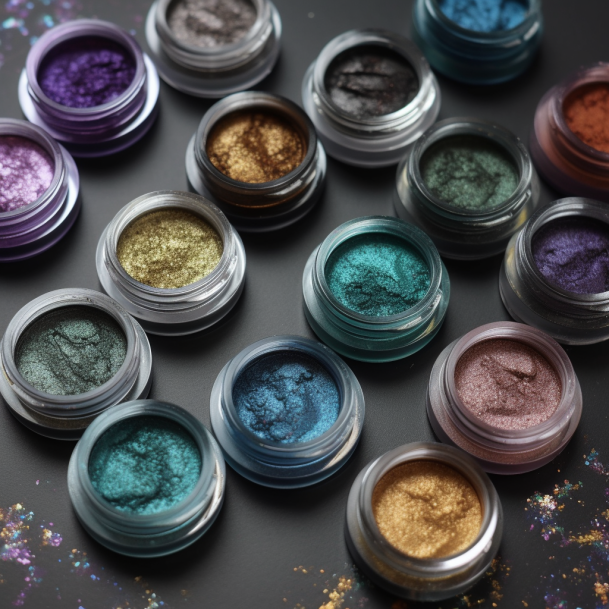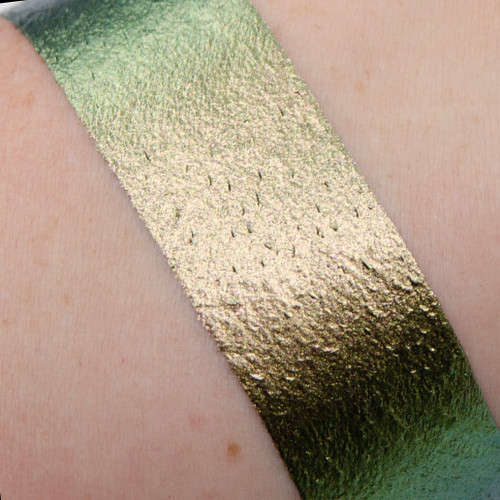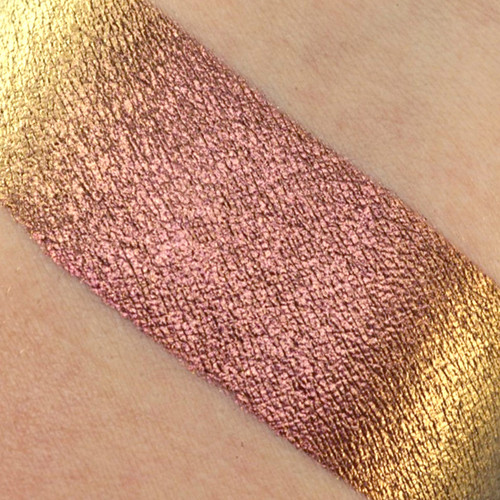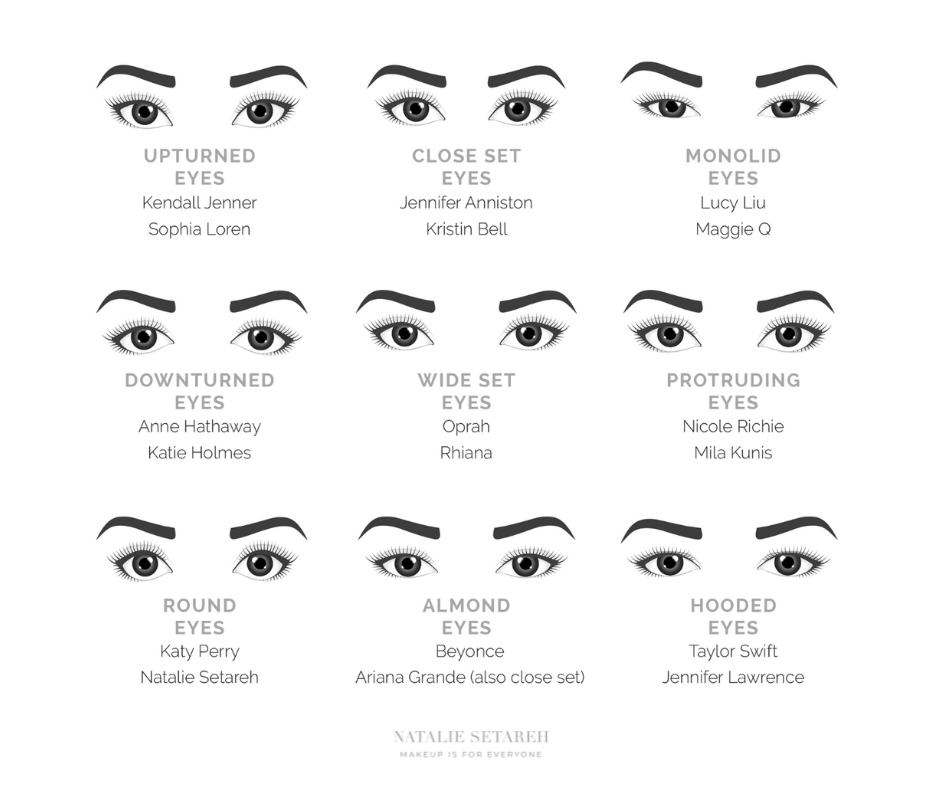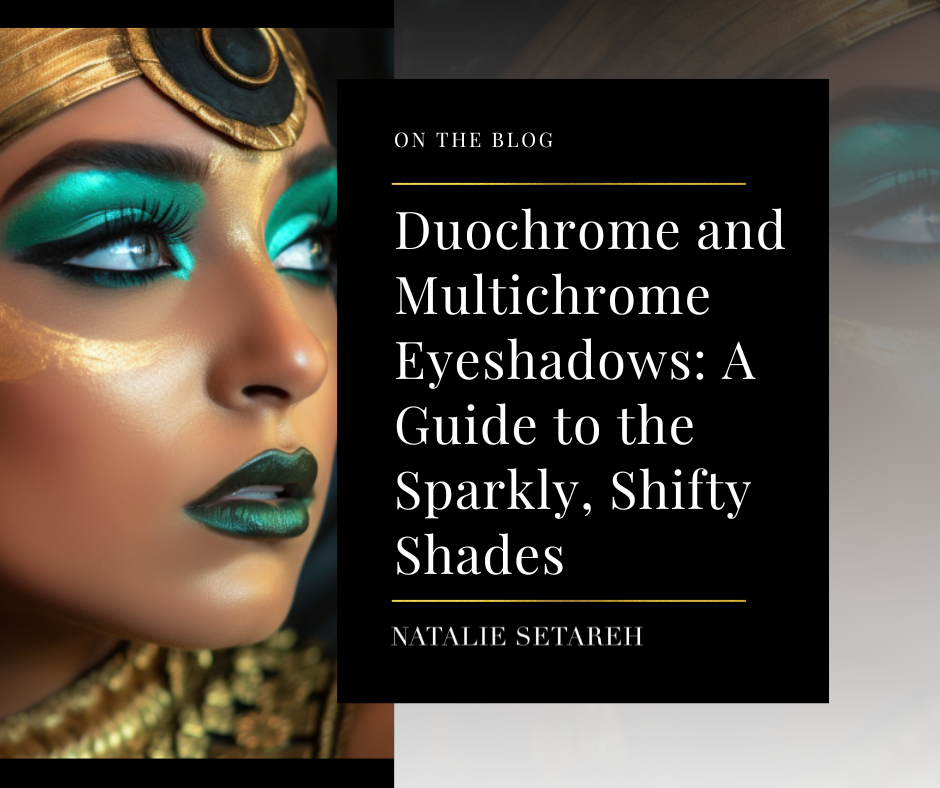
Duochrome and multichrome eyeshadow finishes are becoming more and more popular! While they seem like they are super new and innovative, these eyeshadow finishes have actually been around for a long time.
What Are Duochrome and Multichrome Eyeshadows?
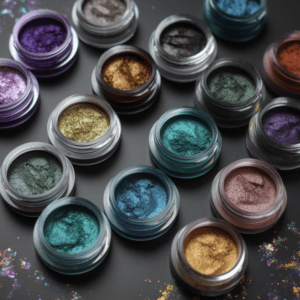
Duochrome and multichrome eyeshadows are a type of eyeshadow finish that appears to change color depending on the angle of view. They offer a mesmerizing twist to your eye makeup. These unique finishes create a captivating effect as they seem to shift in color, transforming with every angle.
Duochrome liquid eyeshadows and loose pigments provide a stunning sheen that reflects multiple hues, offering a dynamic and multidimensional look.
Multichrome eyeshadow palettes are a treasure trove of captivating shades that blend seamlessly together, unveiling a mesmerizing array of colors as they catch the light.
Whether you’re seeking a subtle iridescent effect or a bold, eye-catching transformation, duochrome and multichrome eyeshadows are the perfect choice to add an enchanting touch to your makeup looks.
These Eyeshadows are Big Business
The duochrome eyeshadow market is a relatively new market, but it is growing rapidly. The global duochrome eyeshadow market was valued at $1.2 billion in 2020, and it is projected to grow to $2.5 billion by 2027.
But just because the market is new, that doesn’t mean they haven’t been a part of the beauty scene before now…
Ancient Egypt:
Egyptians used duochrome eyeshadows to create dramatic looks for special occasions. They would often use a combination of green and gold eyeshadows to create a look that was both beautiful and eye-catching.
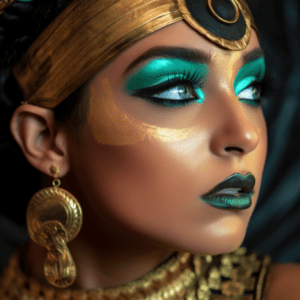
19th century:
Stage performers used duochrome eyeshadows in the 19th century to create dramatic looks. Actors and actresses would often use a combination of different colors to create a look that was both eye-catching and otherworldly.
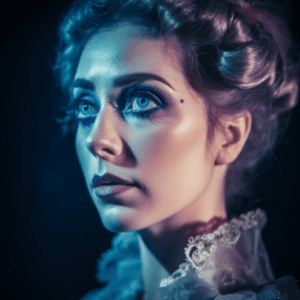
20th century:
In the 20th century, duochrome eyeshadows became more widely available to the general public and were often used to create everyday looks that were both stylish and sophisticated.

How Do These Shadows Work?
Special pigments that reflect light in different ways create the mesmerizing effect of duochrome and multichrome eyeshadow.
The Secret Recipe: 4 Special Pigments
1- Iridescent Pigment
The most common type of pigment used to make duochrome and multichrome eyeshadow is iridescent pigment. Tiny flakes of mica reflect light in different directions, creating the illusion of a rainbow of colors in iridescent pigments.
2- Chromatic pigments
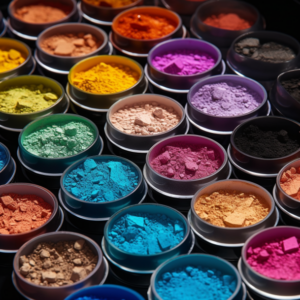
Chromatic pigments are made up of tiny particles that reflect different wavelengths of light. This creates the illusion of a single color that changes depending on the angle of view. Chromatic pigments will typically shift between two or three colors.
Chromatic pigments are created by coating a substrate, such as mica or titanium dioxide, with a thin layer of a reflective material, such as metal or glass. The reflective material is what gives the pigment its shimmering or iridescent appearance.
The type of reflective material used will determine the color of the pigment. For example, a pigment coated with a layer of gold will appear gold, while a pigment coated with a layer of silver will appear silver.
Chromatic pigments can be used to create a variety of effects, including:
- Shimmer: They are especially popular for eye shadow, as they can help to create a more dramatic and eye-catching look.
- Iridescence: This is a type of optical illusion that creates the appearance of a rainbow of colors. Iridescence is often used in cosmetics to create a more glamorous and sophisticated look.
- Holographic: This is a type of optical illusion that creates the appearance of a three-dimensional image. Holographic pigments are often used in cosmetics to create a more futuristic and edgy look.
3- Interference pigments
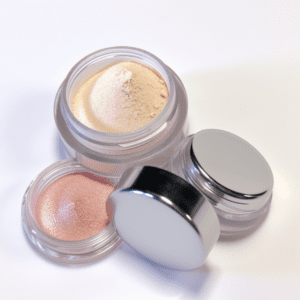
Interference pigments are used in cosmetics, such as eye shadow, lipstick, and nail polish. They are also used in paints, inks, and other decorative applications. Interference pigments are created by depositing thin layers of different materials onto a substrate, such as mica or titanium dioxide. The thickness and refractive index of each layer are carefully controlled to create the desired color effect. For example, a pigment made with layers of titanium dioxide and mica will appear to change color from blue to green to gold.
The type of materials used in interference pigments can vary widely, but some common examples include:
- Mica has a high refractive index and can be easily layered, so it is often used to create interference pigments.
- Titanium dioxide is opaque and can help to reflect light evenly, so it is often used to create interference pigments.
- Metal flakes can be used to create interference pigments that have a metallic sheen.
Interference pigments can be used to create a variety of effects, including:
- Iridescence: Iridescence is a type of optical illusion that creates the appearance of a rainbow of colors. Interference pigments are often used to create iridescent effects in cosmetics and other decorative applications.
- Holography: Holography is a type of optical illusion that creates the appearance of a three-dimensional image. Interference pigments can be used to create holographic effects in cosmetics and other decorative applications.
Interference pigments are a versatile and creative tool that can be used to create a variety of looks. And with so many colors and effects to choose from, there is sure to be an interference pigment that is perfect for any occasion.
4- Metallic pigments
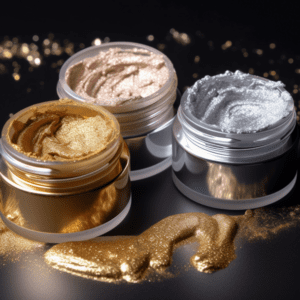
Tiny particles of metallic pigments reflect light in a single direction, creating the illusion of a single, metallic color.
Flakes of metal, such as aluminum, copper, or silver, are made into these products. They are then coated with a clear resin to protect them and make them easier to use.
Metallic pigments come in a variety of colors, including gold, silver, bronze, copper, and more. They also come in different finishes, such as matte, satin, and shimmer.
Metallic pigments add a touch of shimmer to any look.
- Shimmers: They are especially popular for eyeshadow, as they can help to create a more dramatic and eye-catching look.
- Reflective: Popular look for paints and inks, as it can help to create a more eye-catching and dynamic look.
4 Steps To Determine Quality Duochrome and Multichrome Eyeshadow
Step 1: Check Pigmentation
The pigment should be rich and vibrant. Again, the pigment is what gives the makeup its color. Highly pigmented good quality makeup pigments produce a strong color with just a small amount of product.
Step 2: Blendability
The eyeshadow should be easy to blend. Good quality makeup pigments will be easy to blend, meaning that they will blend smoothly and evenly without leaving any streaks or harsh lines.
Step 3: Longevity
Lastly, the eyeshadow should last a while (under most circumstances) without fading or becoming patchy.
Step 4:- Check the Composition
The presence of ingredients like tin oxide and magnesium stearate can greatly enhance the performance of these eyeshadows. Furthermore, oxide helps create a smooth and even application, while magnesium stearate improves adherence and longevity.
The use of calcium aluminum borosilicate contributes to the mesmerizing color shift effect
Selecting The Right Duochrome and/or Multichrome Eyeshadow for Your Eye Color
I can help answer this question for you but when it comes to color selection, I like to make sure you understand a little of the color theory of makeup.
Understanding basic color theory allows you to choose colors that flatter your skin tone and enhance your features. Makeup artists can use color theory to create a variety of effects, from subtle to dramatic.
If you want to understand basic color theory as it pertains to makeup, grab a copy of my book, Be Your Own Makeup Artist. It’s a comprehensive guide to makeup application and covers everything from choosing the right foundation to applying eyeliner. The book also includes a section on color theory, which explains how to use colors to create different looks.
Green Eyes
Look for duochrome eyeshadows with a green or gold shift (and/or blue for multichrome). These colors will help to make your eyes look brighter and more vibrant.
Blue Eyes
Look for duochrome eyeshadows with a blue or purple shift (and/or pink for multichrome). These colors will help to make your eyes look cooler and more mysterious.
Brown Eyes
Look for duochrome eyeshadows with a copper or bronze shift (and/or gold for multichrome). These colors will help to make your eyes look warmer and more inviting.
Hazel Eyes
Look for duochrome eyeshadows with a pink, purple, or gold shift (and/or green for multichrome). These colors will help to bring out the different colors in your eyes.
How to Apply Duochrome and Multichrome Eyeshadow for Your Eye Shape
You can apply duochrome and multichrome eyeshadow to your eyes in a variety of ways, depending on your eye shape. Again, grab a copy of my book to learn about all the different eye shapes and how to identify yours. I also teach this in my course Learn Makeup in 5 Days!
Here are a few tips:
For hooded eyes
Apply the eyeshadow to the lid and blend it up towards the brow bone. You can also use a damp brush to intensify the color and shift.
For deep-set eyes
Apply the eyeshadow to the lid and blend it out towards the crease. You can also use a lighter shade of eyeshadow in the crease to help create depth.
For round eyes
Apply the eyeshadow to the lid and blend it out towards the outer corner of the eye. You can also use a darker shade of eyeshadow in the outer corner of the eye to help create definition.
For almond eyes
Apply the eyeshadow to the lid and blend it out towards the crease. You can also use a shimmery eyeshadow in the inner corner of the eye to help make your eyes look bigger.
Not sure what your eye shape is and want to learn how to wear makeup?
If you’re looking to learn how to apply makeup and eyeshadow specific to your unique face shape and features, I have two options for you. You can work with me 1:1 inside my Create Your Signature Makeup Look program, or you can learn about yourself independently in my virtual Learn Makeup in 5 Days Course.
We will work together to create a makeup routine tailored to your individual needs and preferences in Create Your Signature Makeup Look. We’ll discuss your face shape, skin tone, and eye color, and I’ll teach you how to use makeup to highlight your best features and minimize any areas you’d like to conceal.
If you’re looking for a more independent learning experience, my Learn Makeup in 5 Days Course is a great option. In this course, you’ll learn the basics of makeup application, including how to choose the right products, and how to apply foundation, concealer, blush, bronzer, eyeshadow, eyeliner, mascara, and lipstick. You’ll also learn how to create a variety of looks, from everyday to evening. No matter which option you choose, I’m confident that you’ll learn how to apply makeup in a way that makes you feel confident and beautiful.
Important “Rules” to Keep in Mind
Less Is More
As a general rule, I recommend having 2-3 duochromes and multichromes in your capsule makeup bag collection. This will give you enough variety to create a variety of looks, without being too overwhelming.
Here are a few tips to help you decide:
Consider your personal style
What kind of looks do you like to create? If you prefer subtle looks, you may only need one or two duochromes or multichromes. If you want more dramatic looks, you may want to add a few more to your collection.
Applying these shades on the top of an eyeshadow or on the top of your eyelids can create a subtle color change that catches the light beautifully.
On the other hand, if you have a penchant for bolder looks, grab a duochrome liquid eyeshadow and unleash your creativity!
Think about your skin tone
Some duochromes and multichromes work better with certain skin tones than others. Experiment with a few different colors to see which ones look best on you. These unique eyeshadows offer captivating color shifts and an intense sparkling effect, but certain shades may complement specific skin tones better than others.
Experimenting with a variety of colors allows you to discover which hues truly enhance your complexion and bring out your natural beauty.
If you have a warmer skin tone, find that shades with golden or bronze undertones create a stunning contrast, while those with cooler undertones might prefer iridescent shades with hints of blue or purple.
By exploring different tones and observing how they interact with your skin, you can identify the duochromes and multichromes that best suit you, helping you achieve a mesmerizing and personalized look.
Not sure about your skin tone? My book and my Learn Makeup in 5 Days course will help teach you how to identify your skin tone and you’ll never look back!
Consider the occasion.
If you’re only going to be using your duochromes and multichromes for special occasions, you may not need as many as if you’re going to be using them every day.
Still not sure about how to use these eyeshadows?
Beauty is about perception, not about make-up. I think the beginning of all beauty is knowing and liking oneself. You can't put on make-up, or dress yourself, or do you hair with any sort of fun or joy if you're doing it from a position of correction.
kevyn aucoin
